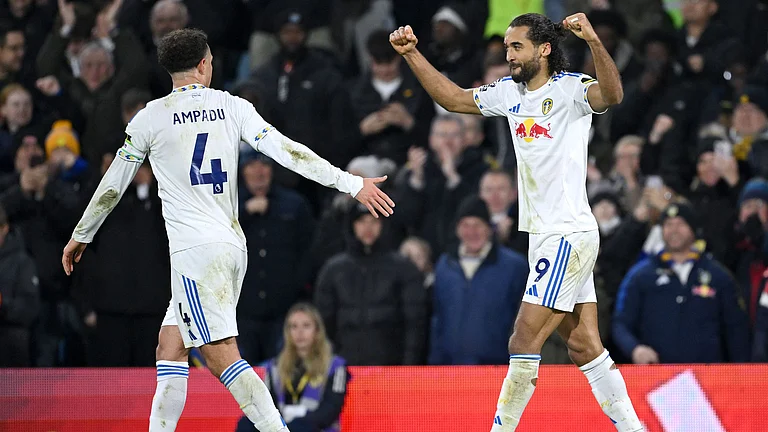But Santa Claus paid Sinha a belated visit on January 13, as the Union cabinet granted him all his wishes. Not only can Sinha now expect to meet his disinvestment target of Rs 5,000 crore, but even exceed that and make up for the other revenue shortfalls this year.
On that day, the cabinet gave permission to a clutch of public sector oil companies to sell a portion of the government's equity in these companies to one another, while mtnl and vsnl have been permitted to buy back their shares from the government. In addition, Indian Oil Corporation (ioc) is also expected to sell a further five per cent of government-owned equity in the Indian market. If Sinha can get all these companies to exercise their options, then, according to some estimates, he could net up to Rs 8,000 crore.
The finance minister's convoluted planwhich is expected to be fine-tuned by the end of this monthenvisages two public sector companies, ioc and the Gas Authority of India Ltd (gail), buying 10 per cent and 2.5 per cent respectively of the Oil and Natural Gas Commission (ongc). ongc would in turn buy out 10 per cent of ioc, and a similar amount of gail's equity. All this is in addition to gail's domestic offering of 10 per cent equity (which could bring in anywhere between Rs 550 crore and Rs 700 crore), roadshows for which are currently in progress. Then, there's also vsnl's gdr issue of 10 million shares, with a greenshoe option of another million shares (that is, if there's enough demand, vsnl can sell another million shares), which should fetch the finance minister somewhere in the range of Rs 800 crore.
| How The Cash Registers | |
| Payments of Government(Rs Crore) | |
| Indian Oil buys 10% of ONGC | 2,800 |
| ONGC buys 10% of Indian Oil | 1,500 |
| ONGC buys 10% GAIL | 700 |
| GAIL buys 2.5% of ONGC | 700 |
Total | |
But getting the public sector companies to agree to this has been hard work for Sinha. In fact, he has been knocking on many doors since September last, when he realised that his disinvestment targets wouldn't be met due to both lacklustre international equity markets and the lack of political initiative on the government's part. Thus the finance ministry first mooted a proposal where financial institutions (FIs) and banks would buy the government's equity in public sector companies, and then offload them at a profit when the market situation improved. But by late December, that plan was shelved as Sinha's team at North Block and chieftains of the Mumbai-based FIs couldn't see eye-to-eye on how much the institutions would be paid for such a service, and how profits from the eventual sell-off would be shared.
Next, the finance ministry thought it would be best if the public sector companies bought back their own shares from the government. That merited a mixed response. The oil companies refused outright. And not without reason either. Says J.K. Jain, director (finance), gail: Buyback reduces a company's borrowing capacity, since its net worth comes down. Reduction in equity is something ioc, which has an equity base of only Rs 389 crore, definitely didn't want. Especially since the recently promulgated buyback ordinance prohibits any fresh issue of equity till two years after buyback. But the two telecom companies didn't seem to mind. Both the vsnl and mtnl boards met and decided that they were agreeable to the buyback option, says a senior mtnl official.But that wouldn't raise much money for the government, since the government's stake in mtnl is already down to 56.4 per cent, and the government wouldn't like to reduce it below 51 per cent. Plus, 2.22 per cent of the company's equity has been reserved for employees. Thus, at bestwith a pro-rata buybackthe government can expect to raise somewhere in the region of Rs 150 crore and Rs 200 crore. And as it's working towards a Eurofloat, vsnl can't buy back a portion of government-owned equity, since gdr issue guidelines mandate a 60-day cooling period.
Just as time and options seemed to be running out for Sinha, the oil companies, if you believe them, proposed the equity swap route themselves. And the oil companies claim to have strong reasons for getting into these interlinkages. Says gail chairman C.R. Prasad, It is important for us to have synergy with ongc, because in any case our operations are in tandem with theirs. They produce the gas, and we transport it through our pipelines. In 2003, when the hydrocarbon sector is opened up and ongc has other companies vying to transport its gas, we will be able to synergise better with them, since we will have a place on the ongc board. The arguments are roughly the same for the ioc-ongc equity swap. ioc has been wanting to backward integrate for some time now, while ongc wanted to get into upstream operations. This equity swap will cater to both their ambitions, says Sanjeev Joshi, senior analyst at dbs Securities.
Sinha himself may heave a sigh of relief now, but there aren't many patting him on the back. For, to begin with, the public sector is being forced to fork out huge sums of money to bankroll the government's non-plan expenditure. Ask any international expert on privatisation (which is what disinvestment should have been called in the first place), and he'll say that that's a strict no-no for the use of sales proceeds. Next, by no stretch of imagination can this be termed disinvestment. Says a Mumbai-based investment banker: Equity swaps mean that the government will stay in total control and these public sector companies will remain accountable to no one but the government. The government, in fact, wants to avoid selling to institutional investors because that would force the public sector to shape up and answer to investors.
But what's causing greater worry is the huge amounts of money that these government-owned companies will have to shell out to help balance Sinha's budget. The scenario, though, may not be all that bad. Take ioc's purchase of 10 per cent of ongc, for instance. ongc has an equity base of Rs 1,425 crore, 10 per cent of which amounts to Rs 142.5 crore. But the 4 per cent of its equity which was disinvested earlier has been quoting in the range of Rs 200 a share on the bourses. That would mean that ioc would face an outgo of a whopping Rs 2,800 crore. How is that going to affect ioc's financial health? ioc should have a cash surplus of Rs 2,700 crore to Rs 2,800 crore next year. Thus, most of the funding for this purchase can come via internal accruals, says Joshi of dbs Securities. Adds Arup Ganguly, research analyst at Anand Rathi Securities: Most of ioc's immediate investments have been taken care of. That's true. ioc's capital expenditure of Rs 3,000 crore for this fiscal and the next has more or less been accounted for. If anything, it just might stop ioc from going ahead with its ambitious petrochemical ventures, which anyway has had some analysts worried.
Then, there is ongc's buying into ioc which, back of the envelope calculations indicate, should cost the company Rs 1,500 crore. Add the 10 per cent stake it will be acquiring in gail, and its gross investments should be in the range of Rs 2,200 crore. How will that affect ongc? Financially, ioc is much stronger than ongc. So, ongc is buying into a healthier company, which also has refining operations that ongc has been wanting to get into for long. ongc is getting to kill two birds with one stone, says Ganguly.
And what about gail's purchase of 2.5 per cent of ongc, which should cost somewhere in the range of Rs 700 crore? We are not wasting any money and are spending only as much as we can afford to. We have completed most of our expansions, and we have a low debt-equity ratio of 0.43:1. So, about half this transaction can be funded through debt, says gail chairman Prasad. Even mtnl is putting up a brave front. If the government wants, we can do a buyback this fiscal. Our equity is only leveraged to the tune of 0.24:1. So there's a lot of scope, says mtnl's finance advisor, S.D. Saxena.
But with the oil companies singlehandedlyand hopefully without getting too badly scarredtaking on Yashwant Sinha's disinvestment burden, the likes of mtnl may get away unscathed. That, of course, depends on how greedy Sinha gets.


























